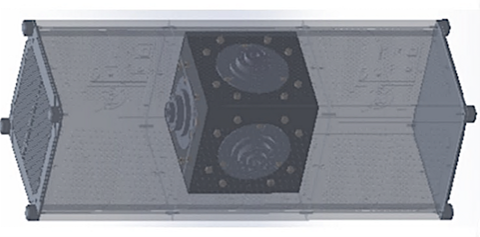
Publicado
Electromechanical flight stabilization system for CubeSat nanosatellites
Sistema electromecánico de estabilización de vuelo para nanosatélites CubeSat
DOI:
https://doi.org/10.15446/dyna.v91n234.115957Palabras clave:
fuzzy control, simulation, virtual reality, electromechanical stabilization system, LEO orbit (en)control difuso, simulación, realidad virtual, sistema electromecánico de estabilización, órbita LEO (es)
Descargas
The objective of the research was to design and simulate a stabilization system for attitude control of CubeSat nanosatellites in LEO orbit. The electronic system was inside the mechanical system, designed in Proteus. The mechanical system was designed in SolidWorks, then a CubeSat 3U CAD was downloaded for simulation and finally, all CAD designs were assembled. These data were used for the analysis of the spatial environmental perturbations of aerodynamic drag, gradient, gravity and magnetic field. Attitude representation was done by analyzing the Euler, Poisson and Quaternions equations. Then, a fuzzy logic control was created with two cases for automatic control. The analysis and virtual reality simulation revealed the correct attitude control on the CubeSat 3U nanosatellite, considering the perturbations of the space environment and a new 25° orientation of each axis.
El objetivo de la investigación fue diseñar y simular un sistema de estabilización para el control de actitud de nanosatélites tipo CubeSat en la órbita LEO. El sistema electrónico estaba dentro del sistema mecánico, diseñado en Proteus. El sistema mecánico se diseñó en SolidWorks, luego se bajó un CubeSat 3U CAD para la simulación y finalmente, se ensamblaron todos los diseños CAD. Estos datos se utilizaron para el análisis de las perturbaciones ambientales espaciales de arrastre aerodinámico, gradiente, campo gravitatorio y magnético. La representación de la actitud se hizo mediante el análisis de las ecuaciones de Euler, Poisson y Quaternions. A continuación, se creó un control de lógica difusa con dos casos para el control automático. El análisis y la simulación de realidad virtual revelaron el correcto control de actitud en el nanosatélite CubeSat 3U, considerando las perturbaciones del entorno espacial y una nueva orientación de 25° de cada eje.
Referencias
[1] Maral, G., Michel, B., and Zhili, S., Satellite communications systems: systems, techniques and technology, John Wiley & Sons, Hoboken, NJ, USA, 2020. DOI: https://doi.org/10.1002/9781119673811
[2] Fourati, F., and Alouini, M.S., Artificial intelligence for satellite communication: a review. Intelligent and Converged Networks, 2(3), pp. 213-243. 2021. DOI: https://doi.org/10.23919/ICN.2021.0015
[3] Kodheli, O., Lagunas, E., Maturo, N., Sharma, S.K., Shankar, B., Montoya, J.F.M., and Goussetis, G., Satellite communications in the new space era: a survey and future challenges. IEEE Communications Surveys & Tutorials, 23(1), pp. 70-109, 2020. DOI: https://doi.org/10.1109/COMST.2020.3028247.
[4] Prol, F.S., Ferre, R.M., Saleem, Z., Välisuo, P., Pinell, C., Lohan, E. S., ... and Kuusniemi, H., Position, navigation, and timing (PNT) through low earth orbit (LEO) satellites: a survey on current status, challenges, and opportunities. IEEE Access, 10, pp. 83971–84002. 2022. DOI: https://doi.org/10.1109/ACCESS.2022.3194050
[5] Malisuwan, S., and Kanchanarat, B., Small satellites for low-cost space access: launch, deployment, integration, and in-space logistics. American Journal of Industrial and Business Management, 12(10), pp. 1480-1497, 2022. DOI: https://doi.org/10.4236/ajibm.2022.1210082
[6] Murugan, P., and Agrawal, Y., Small satellites applications, classification and technologies. International Journal of Science and Research (IJSR), 9(7), pp. 1682-1687, 2020. DOI: https://doi.org/10.21275/SR20723213825
[7] İnce, F., Nano and micro satellites as the pillar of the “new space” paradigm. Journal of Aeronautics and Space Technologies, [online]. 13(2), pp. 235-250, 2020. Available at: https://jast.hho.msu.edu.tr/index.php/JAST/article/view/420
[8] Saeed, N., Elzanaty, A., Almorad, H., Dahrouj, H., Al-Naffouri, T.Y., and Alouini, M.S., CubeSat communications: recent advances and future challenges. IEEE Communications Surveys & Tutorials, 22(3), pp. 1839-1862, 2020. DOI: https://doi.org/10.1109/COMST.2020.2990499.
[9] Freire, F., Shilenkov, Е., Titenko, E., Frolov, S., and Shitov, A., Mathematical model of the earth's magnetic anomalies. Revista Técnica de la Facultad de Ingeniería Universidad del Zulia, [online]. 43(S1), pp. 35-39, 2020. Available at: https://produccioncientificaluz.org/index.php/tecnica/article/view/31066/47095
[10] Wailand, A., and Bauer, R., Investigation of gain tuning and sensor noise for CubeSat B-dot detumbling and 3-axis PD magnetic attitude control, Proceedings of the Canadian Society for Mechanical Engineering International Congress, [online]. 2020. Available at: https://library.upei.ca/islandora/object/csme2020%3A31/datastream/PDF/download/csme2020%3A31.pdf
[11] Gaber, K., El Mashade, M.B., and Aziz, G.A.A., A hardware implementation of flexible attitude determination and control system for two-axis-stabilized cubesat. Journal of Electrical Engineering & Technology, 15, pp. 869-882, 2020. DOI: https://doi.org/10.1007/s42835-020-00352-6
[12] Yang, Y., Spacecraft modeling, attitude determination, and control: quaternion-based approach, Rockville, Maryland, USA: CRC Press, 2019.
[13] Wang, Z., Smart attitude control system for small satellites, Doctoral dissertation, Faculty of Engineering, School of Aerospace Mechanical and Mechatronic Engineering, The University of Sydney, Australia, 2022. Available at: https://hdl.handle.net/2123/29905
[14] Shehzad, M.F., Asghar, A.B., Jaffery, M.H., Naveed, K., and Čonka, Z., Neuro-fuzzy system based proportional derivative gain optimized attitude control of CubeSat under LEO perturbations, Heliyon, 9(10), art. 20434, 2023. DOI: https://doi.org/10.1016/j.heliyon.2023.e20434
[15] Gordon, R., Worrall, K., and Ceriotti, M., Attitude control of a nanosatellite using inverse simulation, Proceedings of 72nd International Astronautical Congress 2021, pp. 833-847. Attitude Control of a Nanosatellite using Inverse Simulation. In: 72nd International Astronautical Congress 2021, Dubai, United Arab Emirates, 25-29 Oct 2021, pp. 833-847.
[16] Liu, H.L., Wu, Y.S., Wan, L.C., Pan, S.J., Qin, S.J., Gao, F., and Wen, Q.Y., Variational quantum algorithm for the Poisson equation. Physical Review A, 104(2), art. 022418, 2021. DOI: https://doi.org/10.1103/PhysRevA.104.022418
[17] Krishna, A.B., Sen, A., and Kothari, M., Super twisting algorithm for robust geometric control of a helicopter. Journal of Intelligent & Robotic Systems, 102 art. 61, 2021. DOI: https://doi.org/10.1007/s10846-021-01366-6
Cómo citar
IEEE
ACM
ACS
APA
ABNT
Chicago
Harvard
MLA
Turabian
Vancouver
Descargar cita
Licencia
Derechos de autor 2024 DYNA

Esta obra está bajo una licencia internacional Creative Commons Atribución-NoComercial-SinDerivadas 4.0.
El autor o autores de un artículo aceptado para publicación en cualquiera de las revistas editadas por la facultad de Minas cederán la totalidad de los derechos patrimoniales a la Universidad Nacional de Colombia de manera gratuita, dentro de los cuáles se incluyen: el derecho a editar, publicar, reproducir y distribuir tanto en medios impresos como digitales, además de incluir en artículo en índices internacionales y/o bases de datos, de igual manera, se faculta a la editorial para utilizar las imágenes, tablas y/o cualquier material gráfico presentado en el artículo para el diseño de carátulas o posters de la misma revista.

















